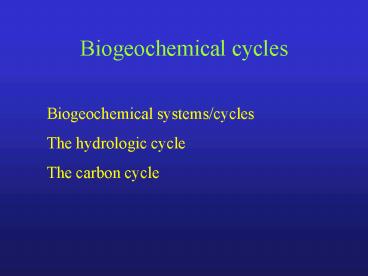Biogeochemical cycles PowerPoint PPT Presentation
1 / 33
Title: Biogeochemical cycles
1
Biogeochemical cycles
Biogeochemical systems/cycles The hydrologic
cycle The carbon cycle
2
Cycles
- Budgets
- Feedbacks
- Rates of change
3
Cycle concepts
- We use the concept of cycles to calculate budgets
- Substances in a cycle reside in reservoirs
- Reservoirs can be sources or sinks.
- These substances move between reservoirs by
processes or mechanisms the rate at which they
move is called a flux - Measuring fluxes and amounts in reservoirs allows
us to calculate residence times.
4
The hydrologic cycle
5
Some numbers for the hydrological cycle
6
Quantifying fluxes.
is a step towards understanding controls on the
system
7
What is the residence time of water in the ocean
today?
- ? total amount of substance in a reservoir
- rate of supply or removal
8
The hydrologic cycle
9
Residence time of water in the ocean
- If the volume is 1370x106 km3
- And the rate of removal is 425 x 103 km3 yr-1
- Then what is the residence time of water in the
ocean? - Any residence time calculation assumes steady
state.
10
Some numbers for the hydrological cycle
11
The hydrologic cycle
12
Residence time of water in the ocean
- ? 1370x106 km3 3224 yrs
- 425x 103 km3 yr-1
- This calculation assumes steady state.
- If the flux changes then the size of the
reservoir changes..
13
Timescales
The residence time defines the time scale
The the flux controls the rate of exchange in the
reservoir If they are not in balance the system
isnt in equilibrium
14
The hydrologic cycle
Changes in fluxes change reservoir size this
can result in Glacial build up and decay Fluxes
control the rates of change.
15
The carbon cycle
Unlike the hydrological cycle, the carbon cycle
involves a lot of chemistry. And a lot of that
involves ?CO2 and biological transformations
16
The carbon cycle
Has much longer timescales than the hydrocycle
a.k.a. the Wilson Cycle
17
The carbon cycle quantified
18
Residence time of carbon in the deep ocean
- ? amount in reservoir Gt ? yrs
- flux Gt yr-1
- What this tells us is the timescale of the
reservoir
19
Residence time of carbon in the deep ocean
- ? 38100 Gtons 380 yrs
- 100.2 Gt yr-1
- This is a short to midterm timescale reservoir..
20
The carbon cycle
The sediment reservoir is huge. Its both organic
and carbonate carbon.
21
Residence time of carbon in the sediment
reservoir
- How long does carbon stay in the sediments?
- ? 5x107 Gt 996,016 yrs 1million yrs
- 50.2 Gt yr-1
- This is a long timescale reservoir..
- Fluxes tend to reflect the reservoir times
22
How do we apply this concept?
- And how can we use these numbers to understand
the dynamics of the earth as a system? - Lets look at a long term change
- The concept of reservoirs and residence time is
very powerful.
23
The ocean is both a source and sink for CO2.
In different places and at different times
24
The CO2 Climate connection
CO2 is held in the deep ocean. how much is held
is a function of circulation How long it is held
is a function of circulation. (the overturning
rate of the ocean) What happens if circulation
changes? what if we slow down thermohaline
circulation?
25
160,000 yr record of atmospheric CO2
- The rapidity of this change meant that the CO2
must be exchanging with the ocean reservoir - not the sediments (too fast).
- The bio-pump and carbonate dissolution are of the
right magnitude and timescale
The record of CO2 levels in the atmosphere
measured in bubbles trapped in ice cores
26
The CO2 Climate connection
How much CO2 in the ocean controls the levels in
the atmosphere How fast the ocean circulates
controls can change the amount of CO2 in the
atmosphere to change climate The carbon cycle IS
the climate cycle.
27
The carbon cycle
The biota reservoir is tiny. (note the size) The
flux is huge (note the values)
28
Residence time of carbon in the ocean biota
reservoir
- ? 3G tons 0.06 yr 22 days
- 50 Gt yr-1
- This is a very short timescale reservoir..
- Carbon cycles very quickly through this reservoir
29
Biotic reservoir has short residence times
Seasonal fluctuations in the concentration of
atmospheric carbon dioxide are controlled by the
fluctuations in photosynthesis
30
The hydro and carbon cycle effect on climate
- The combination of the changes in
- The hydrologic cycle how fast the ocean can
cycle (i.e. residence time in the ocean) - Changes in the carbon cycle (the bio-pump CaCO3
sediment dissolution) - Combine to control the rate at which the CO2 in
the atmosphere is changed.
31
(No Transcript)
32
The ?13C reflects traces the concentration of
?CO2 in the deep ocean
33
The ?13C reflects the global thermohaline
circulation
Duplessey et al., 1988

